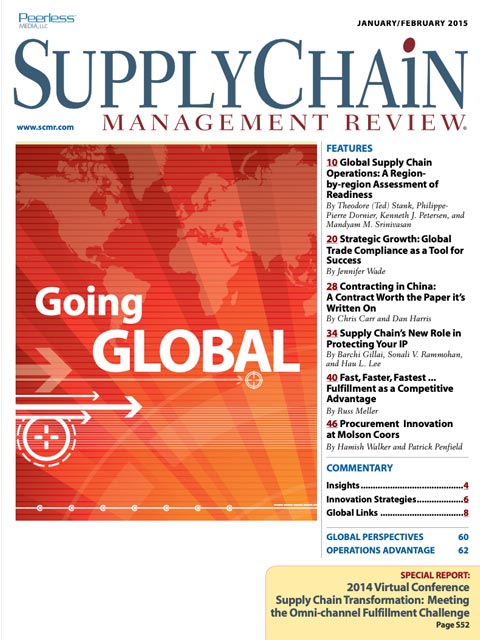Sorry, but your login has failed. Please recheck your login information and resubmit. If your subscription has expired, renew here.
January-February 2015
As long as there have been boats and beasts of burden, intrepid business professionals, governments, and marauders have sought fame, fortune, wealth, and value by going global. Think the Phoenicians, Marco Polo, and the Vikings in days of old. Or in contemporary times, think of China, BRIC, EMEA, and other emerging markets. One could argue that outsourcing to China a few decades ago gave birth to supply chain management as we think of it today. This month we’re including an online bonus column from APQC. While this issue focuses on global management, we didn’t want to miss out on the column. Browse this issue archive.Need Help? Contact customer service 847-559-7581 More options
On April 15, 1981, Coca-Cola Company opened its first bottling plant in China since the communist revolution in 1949. On that date, chairman Roberto C. Goizueta noted that it was “…one of the most important days … in more ways than one, in the history of the world.” Regardless of whether or not that bold statement holds true, the return of Coke’s manufacturing operations to China provides an example of how firms are implementing strategies that meet the needs of both developed as well as developing world markets.
To support this marked trend towards globalization, supply chain management has become an increasingly important function for firms that operate with a global footprint, regardless of size or location. What is true for large companies is also true for small- and medium-sized enterprises (SMEs). When a Turkish SME decides to go outside its domestic market to Africa, for example, it has to master not only the African market but also the way it manages the supply chain in this region.
The scope of global supply chain operations is increasing as firms expand their global footprint. According to The World Economic Forum, the ratio of trade to GDP for the world as a whole has increased from 39 percent in 1990 to 59 percent in 2011. Such globalization led to the rapid ascent of developing nations in the early part of the 21st century. Without question, firms in one nation increasingly depend on firms from other nations for the supply of material and services as well as for access to consumer markets. In fact, research into market trends has suggested that supply chains across the world will evolve into a series of regional demand and supply “pods” where regional procurement and manufacturing operations will supply the major demand centers of the area, at least for a significant percentage of production requirements.
 |
This complete article is available to subscribers
only. Click on Log In Now at the top of this article for full access. Or, Start your PLUS+ subscription for instant access. |
SC
MR
Sorry, but your login has failed. Please recheck your login information and resubmit. If your subscription has expired, renew here.
January-February 2015
As long as there have been boats and beasts of burden, intrepid business professionals, governments, and marauders have sought fame, fortune, wealth, and value by going global. Think the Phoenicians, Marco Polo, and… Browse this issue archive. Access your online digital edition. Download a PDF file of the January-February 2015 issue. |
Download Article PDF |
On April 15, 1981, Coca-Cola Company opened its first bottling plant in China since the communist revolution in 1949. On that date, chairman Roberto C. Goizueta noted that it was “…one of the most important days … in more ways than one, in the history of the world.” Regardless of whether or not that bold statement holds true, the return of Coke’s manufacturing operations to China provides an example of how firms are implementing strategies that meet the needs of both developed as well as developing world markets.
To support this marked trend towards globalization, supply chain management has become an increasingly important function for firms that operate with a global footprint, regardless of size or location. What is true for large companies is also true for small- and medium-sized enterprises (SMEs). When a Turkish SME decides to go outside its domestic market to Africa, for example, it has to master not only the African market but also the way it manages the supply chain in this region.
The scope of global supply chain operations is increasing as firms expand their global footprint. According to The World Economic Forum, the ratio of trade to GDP for the world as a whole has increased from 39 percent in 1990 to 59 percent in 2011. Such globalization led to the rapid ascent of developing nations in the early part of the 21st century. Without question, firms in one nation increasingly depend on firms from other nations for the supply of material and services as well as for access to consumer markets. In fact, research into market trends has suggested that supply chains across the world will evolve into a series of regional demand and supply “pods” where regional procurement and manufacturing operations will supply the major demand centers of the area, at least for a significant percentage of production requirements.
 |
SUBSCRIBERS: Click here to download PDF of the full article. |
SC
MR

Latest Supply Chain News
Latest Podcast

 Explore
Explore
Latest Supply Chain News
- AdventHealth named top healthcare supply chain by Gartner
- Geopolitical readiness in supply chains: Strategic challenges for leaders
- Unlocking retention: The role employee engagement plays
- Can supply chain managers embrace an entrepreneurial mindset?
- Challenges to ESG reporting
- With capacity to spare, logistics real estate demand remains subdued
- More latest news
Latest Resources

Subscribe

Supply Chain Management Review delivers the best industry content.

Editors’ Picks





